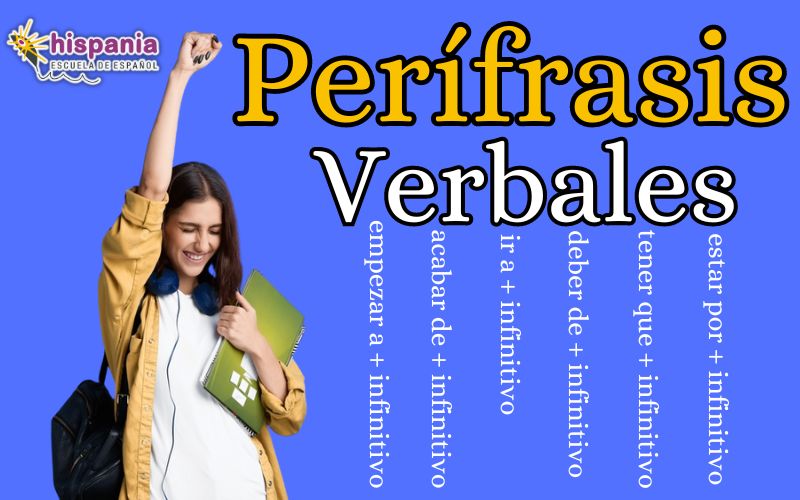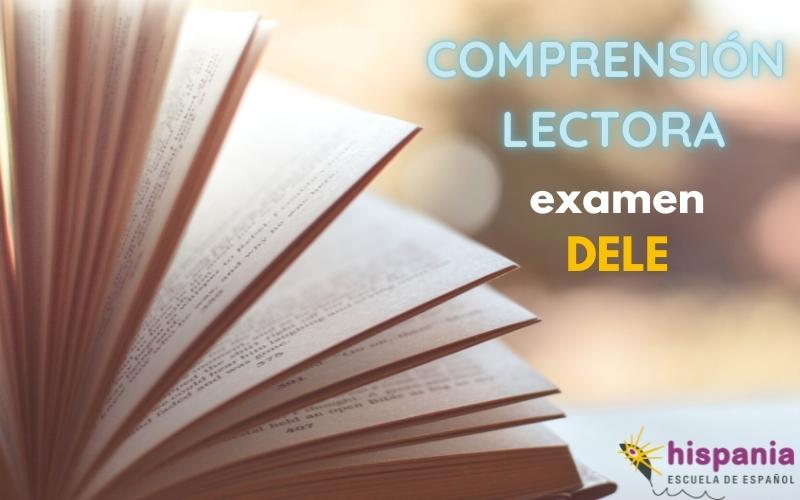
10 Tips for passing the DELE exam reading comprehension
Are you taking the DELE exam preperation course or the exam itself?
We have already spoken on other occasions about this exam.
Today we are going to focus on the reading comprehension in the exam.
This test is one of four sections of the exam.
So,what is reading comprehension?
It is the ability to understand written text, both what the words literally mean, as well as the meaning behind them.
Reading comprehension is often the most complicated part of the DELE exam .
Many people find this section difficult because Spanish is so different to their native language, or because the texts are too complicated.
In this article I am going to give you 10 pieces of advice to help you pass the exam successfully.
We will take a look at the various reading levels and at the end we will evaluate each task for every level in the DELE reading comprehension. As well as, learning a few tricks on how to do well in the exam.
Don't miss out... ¡Empezamos!
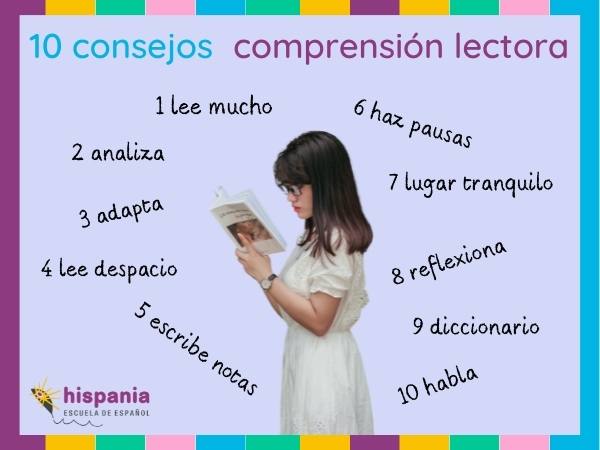
10 General tips for improving your reading comprehension
¿How to work and improve reading comprehension?
So following the 10 pieces of advice What I'm going to give you next. 😉
They are advice that requires perseverance and well in advance before taking the exam. So take them easy.
if you follow them, tu DELE examiner you will be amazed at how well it will turn out for you.
1. Read a lot
Do you like to read?
If so, you're lucky because having the habit of reading, the proof of reading comprehension and exercises They won't be a big problem for you.
In the event that you are not used to reading, you will have to make an effort.
When we say read, we don't just mean creative writing.
You can reading news, internet articles, comics, magazines… look for what you like the most and start there. This will make it easier to get into the habit.
2. Think and analyze what you are reading about
I remember when I was in school that a teacher forced us to read books in class from time to time.
We had a small library, I would pick up any book and quietly read at my desk.
But you know what?
There was a problem.
As I read, my head was thinking about other things. Since I didn't pay attention to the text, I would later forget everything I had read.
To avoid this, think and analyze about what you are reading.
When reading texts in another language it will be even more difficult. Nothing happens.
Stop as long as you need.
Don't be like me when I was little and pay attention to reading. ????
3. Adapt the chosen texts to your level
If you're going to climb a mountain you don't start at the peak, do you?
Well, the same thing happens here.
Read texts or books in Spanish that they are in a level well above yours will frustrate you because there will be many words that you will not understand.
On the other hand, if you read texts that are too easy, you will get bored and feel that you are wasting your time.
We don't want to get frustrated or bored.
For that, look for texts adapted to your level.
4. Read slowly, rushing is not good
enjoy the readings.
It is true that in the exam you will have a time limit and you will not be able to stop too long.
Don't worry. First acquire the habit of reading a lot and little by little you will gain speed
If you get used to reading too fast there will be many details that will escape you.
Read slowly, rushing is never good.
5. Take note of what you are reading
while you read, take notes of vocabulary, of some interesting ideas, of what you don't understand, of what you see as most relevant... of everything.
There is no better way to assimilate something than writing it down.
It is one of the best reading comprehension strategies that speak.
6. Pause between paragraphs to absorb ideas
¿How to get the main ideas of a text?
One of the best ways is pause at the end of paragraphs.
These little pauses between paragraphs they will help you assimilate the ideas and synthesize them.
Think of these pauses as a deep breath.
7. Find a quiet place to read
¿How to concentrate to read?
Are you that kind of person who needs absolute silence to concentrate?
Welcome to the club, I'm like that too.
And, clearly, in reading there are no exceptions.
Find a quiet place to read: a room isolated from noise, a library, a park with few people...
8. Reflect on what you have read
In some reading comprehension tasks at advanced levels, it is necessary to reflect in order to give one's own assessment.
Reflect on what you read means to draw a conclusion.
Practice this, develop your capacity for reflection with everything you read.
9. Use a Spanish dictionary
When reading texts or books in Spanish, the dictionary should be your ally.
It is clear that you cannot search for all the words that you do not understand because it can take a long time and many pauses in reading and therefore, you can lose the thread of the topic.
Try to find the ones that are repeated, the most important.
Those keywords that if you don't understand them, you won't understand the rest of the sentence either.
Searching for words in the dictionary requires patience and will make reading even more leisurely.
But what is more rewarding than learning a new word and understanding a sentence that you couldn't understand before?
10. Talk about what you have read
Tell someone what you have read is another infallible method to improve your reading comprehensions.
By doing this, you will put your own words to what you have read and you will assimilate it much better.
In addition, you will practice the skill of making summaries.
Find a friend who knows how to listen and talk to him about the content of your reading.
Ask him questions about what you tell him, in this way you will see if your speech is clear and if he understands you well.

different reading levels
Did you find my 10 tips and reading comprehension techniques?
I hope so. 🙂
Now let's talk about the reading levels.
These levels will help us understand DELE tasks and what type of reading they look for in each one.
1. Literal level: what does the text say?
This is the First reading what should we do.
At literal level we must understand the information explicit from the text.
That is to say: the word comprehension, interpret sentences well, recognize grammatical structures and understand the topic of the text.
2. Inferential level: what assessment can I make of the text?
At inferential level we add our personal experience and our intuition to interpret what the author means.
It is time to make assumptions and interpret, according to our opinion, what the author wants to express.
3. Level critic: what judgment do I have about the text?
At the critical level, content evaluation.
But be careful: Evaluating the text does not mean saying only if you like it or not.
you must give some arguments convincing to defend your assessment.
How to control these 3 types of reading and use them in the DELE exam
Control these 3 types of reading and comprehension is fundamental.
In the end, are the skills What do they ask for in the reading comprehension test tasks in the DELE exam, especially in the high levels.
We are going to offer you a series of tips to develop and strengthen them in preparing for and taking the exam.
Think about what previous knowledge you have about the topic of the text
Whatever the topic of the reading comprehension texts, surely you have some related background knowledge.
This will help you to understand it better, to interpret it properly and to argue your opinion.
In case you don't have knowledge about that topic, focus on what the text tells you and developing a inferential level included in the song and it's critical level about that information.
Don't make up things about something you don't know.
Look for information in the title, images or even in the text index to better understand
Have you ever heard the following expression?
"A picture is worth a thousand words".
Sometimes in images we can extract a lot of information. Also in the title or in the index.
Think that they are elements that give representative information of the text that you are going to read.
So take a good look at the images and read the titles and indices.

Make connections between what you know and the text
If you have knowledge about the topic of the text, use it to your advantage and prove it.
This is especially useful in levels C1 and C2, in which the reading, oral and written tests are mixed.
Even if there are parts of the text that you don't understand, adding your knowledge will make it appear that you have understood the text better.
With this, I do not mean that you talk about things that have nothing to do with the text.
NEVER do that.
Always stick to the content they offer you and use your knowledge to complement the text and add valuenot to divert the subject.
Create mental images or schemes on the text
The human mind works very well when we associate ideas.
That's why it's good create mental images associated with some words or parts of the text.
You can also make schemes to classify ideas and improve Reading Comprehension.
Ask yourself about what you read to get new ideas
while you're reading the reading comprehension exercises, try to ask questions:
- “What did the author mean in this sentence?”
- “What words can I use in this context to appear more technical and formal?”
- “What do I really think about this topic?”
This is a very kind of questions They will be very useful for you inferential understanding and critical, since they will serve you for get new ideas y create better arguments.
Look for what the author is trying to convey and relate it to your ideas
Try to analyze what the author wants to convey and relate it to your ideas.
Once again, do the correct questions This section will be very useful to you:
- “Why is the author so interested in this topic?”
- “Why have you put so much emphasis on this paragraph?”
- “What do you want to convince me of?”
- “Do I agree with your ideas or disagree on some things?”
Write or tell what the text says in your own words
For better understand the texts of reading comprehension, make your own summaries can help you.
Write or tell what the text says in your own words.
Add everything you know and your conclusions to better understand the text itself
I return to the idea of add your knowledge about the text.
When you write about what you know and provide your conclusions, you also you improve comprehension ability of the text itself.
Therefore, do not be afraid and contribute your knowledge and opinions.
Always with an appropriate language and with information related to the content.
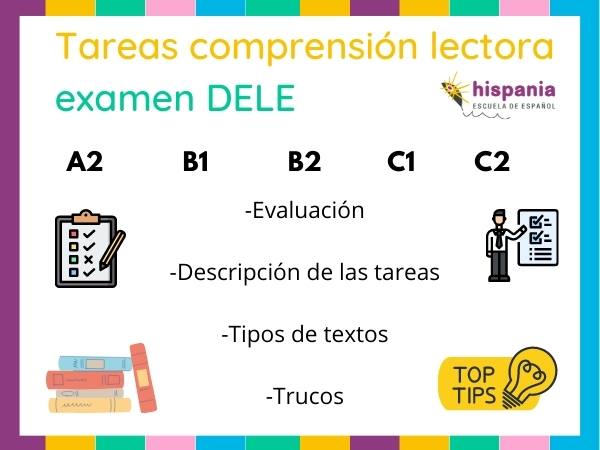
Reading comprehension tasks in the DELE exam
How many tips and reading techniques I have given you today!
I should be the official adviser of the DELE exam. 😁
Next, I'm going to break down reading comprehension test tasks at each level by answering the following questions:
- What is evaluated?
- How is the homework?
- How are the texts?
- Tips to do it right
Thus, you will have super clear everything about this test and you will be able to pass it with the highest grade. 😊
The information that I am going to offer you about the I have extracted the first three questions from the Cervantes Institute.
In the portal Instituto Cervantes DELE exam está all the detailed information of the exams and of each test.
You can see them reading comprehension specifications y practice with test models.
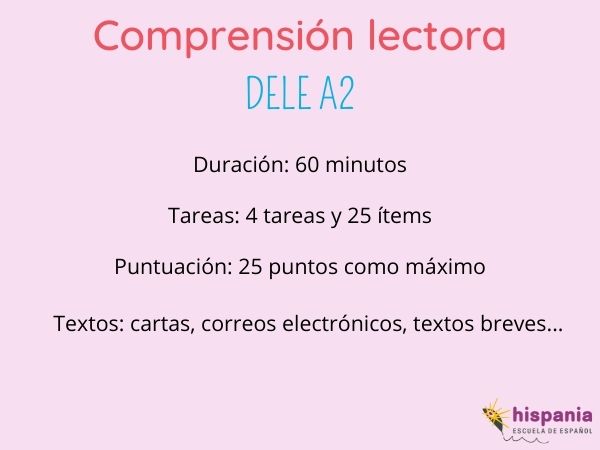
Reading comprehension Level a2
We start with him basic level: A2. The test reading comprehension at this level has 4 tasks with 25 items total. Hard 60 minutes and has a maximum score of 25 points.
Homework 1
- What is evaluated?
Extract the main idea and identify specific and simple information.
- How is the homework?
Read a text and answer five questions with three answer options each.
- How are the texts?
Basic texts of personal letters, emails, short texts. Length: 250-300 words.
- Tips to do it right
read well the texts with questions, underline the important words.
Discard the options of the questions that you do not see in the text.
Homework 2
- What is evaluated?
Extract relevant ideas and identify explicit information.
- How is the homework?
Eight texts to read and answer questions with three options answer each.
- How are the texts?
Short informative texts: magazine articles, brochures, advertisements, posters, etc. Length: 50-80 words, each text.
- Tips to do it right
Familiarize yourself with these types of texts before going to the exam. They are very short and you can find them very easily on the internet.
Homework 3
- What is evaluated?
Extract specific information in informative texts or commonly used descriptions.
- How is the homework?
Read three texts and relate them to the six statements that correspond to each.
- How are the texts?
They are simple informative or promotional materials: magazines, newspapers, brochures, forums, recipes... Length: 100-120 words, each text.
- Tips to do it right
Since there are three different texts, take your time to read them and get the important ideas from all three. Don't be in a hurry to move on to the next text ahead of time.
Homework 4
- What is evaluated?
Identify essential ideas and topic changes in narrative texts short and simple.
- How is the homework?
Read a text and answer six questions with three response options.
- How are the texts?
Biographical reviews on current figures, blog entries, stories, magazines, travel guides, etc. Length: 375-425 words.
- Tips to do it right
Here we have a longer text. Remember to take the pauses in the paragraphs and take notes.

Reading comprehension Level B1
We enter the intermediate level: B1. The reading comprehension test is hard 70 minutesHas 5 sections with 30 items. The maximum score is 25 points.
Homework 1
- What is evaluated?
Extract the main idea and identify specific information in very short texts.
- How is the homework?
Read nine short texts and match six of them with the six statements that correspond to them.
- How are the texts?
Advertisements, billboards, notices... Length: texts of 20-60 words;
- Tips to do it right
Look for the most relevant information in each text to later relate it to the 6 statements. Being so short, it will not be difficult.
Homework 2
- What is evaluated?
Extract main ideas and identify specific information in texts simple informative
- How is the homework?
Read a text and answer six questions with three response options.
- How are the texts?
Information text. Length: 400-450 words.
- Tips to do it right
Before you start reading the text, read the questions first and take note of the keywords. This way you will know what you should pay more attention to.
Homework 3
- What is evaluated?
Locate specific information in descriptive, narrative, or informative.
- How is the homework?
Read three texts and relate them to six sentences.
- How are the texts?
Anecdotes, travel guides, experiences, excerpts from biographies... Length: 100-120 words each text.
- Tips to do it right
Read a text first and match it with the corresponding sentences. Beam the same with the second and then with the third.
Homework 4
- What is evaluated?
Reconstruct a text from its cohesive elements.
- How is the homework?
Read an incomplete text and select, from the eight available fragments, the six that complete it.
- How are the texts?
Catalogs, instructions, recipes, narrative texts... Length: 400-450 words.
- Tips to do it right
Read the text and step by step reconstruct the gaps looking for the fragment that best fits, follow the order of the text. Do it in a draft first because it is possible that as you go along you will want to rectify.
Homework 5
- What is evaluated?
Identify and select grammatical and lexical structures to complete simple texts.
- How is the homework?
Read a text with six spaces and choose one of the three available options for each space.
- How are the texts?
Letters to the director, formal letters, electronic messages. Length: 150-200 words.
- Tips to do it right
Study and master Spanish grammar at B1 level.
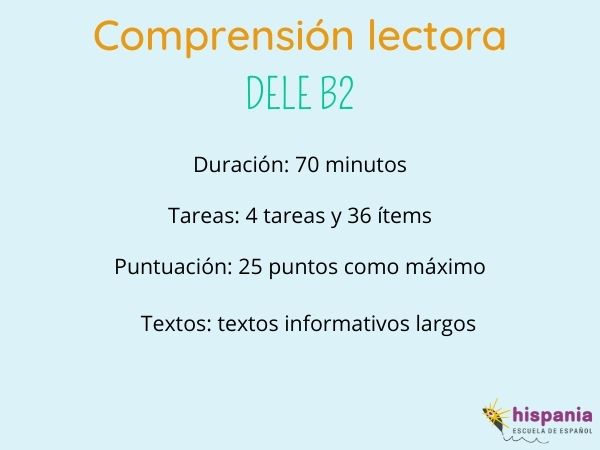
Reading comprehension Level B2
We continue with the intermediate level. Now we went up to exam DELE B2. The reading comprehension test at this level lasts 70 minutes and has 4 tasks with 36 items. The maximum score is 25 points.
Homework 1
- What is evaluated?
Understand relevant ideas and concrete information in texts complex information.
- How is the homework?
Read a text and answer six questions with three response options each. XNUMX o'clock
- How are the texts?
Complex informative texts. Length: 400-450 words.
- Tips to do it right
The text can be complex and have many words that you do not know. Don't stress about this; focus on answering the questions and try to guess the meaning of words that you do not know from the context.
Homework 2
- What is evaluated?
Locate specific and relevant information and extract feelings or author's evaluations.
- How is the homework?
relate four readings with questions or statements.
- How are the texts?
Four expository texts containing different points of view, comments, anecdotes, etc., on the same topic. Extension: 130-150 words each text.
- Tips to do it right
Choose one of the four texts, read it and then try to match it with the corresponding statements.
Do the same with the other 3 texts.
Homework 3
- What is evaluated?
Reconstruct the structure of a text and identify the relationship between ideas.
- How is the homework?
Read an incomplete text and identify, among eight possible fragments, the which correspond to its six spaces.
- How are the texts?
Opinion articles, news, letters to the editor... Length: 400-450 words.
- Tips to do it right
Read the text and try to match each space with the most logical statement have. Do it first in draft in case you rectify later.
Homework 4
- What is evaluated?
Identify appropriate grammatical and lexical structures to complete a complex text.
- How is the homework?
Read a text with fourteen spaces and choose one of the three options available for each space.
- How are the texts?
Literary, historical texts, biographies... Length: 400-450 words
- Tips to do it right
You must know very well the grammar and lexicon of the Spanish B2 level.
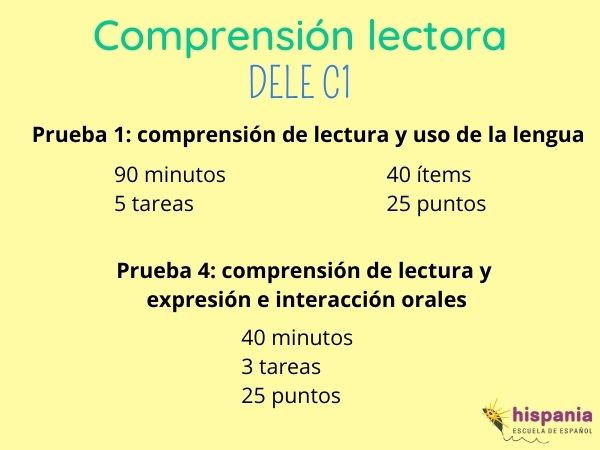
Reading comprehension Level C1
We arrived at advanced level. From DELE C1, all skills are mixed (reading, listening, speaking and writing). All tests have a little bit of everything.
I'm going to focus on the Test 1: reading comprehension and language use.
It is the test that works the most Comprehensive reading exercises.
In this test there 5 tasks with 40 items. Hard 90 minutes and has a maximum of 25 points.
Homework 1
- What is evaluated?
Understand the general idea and specific data.
- How is the homework?
Read a text and answer six questions with three response options.
- How are the texts?
Instructions, contracts, prospectuses, reports... Length: 650-750 words.
- Tips to do it right
As the text is quite long, do a first reading of everything. Then, select the statements one by one and look for the information in the text.
Homework 2
- What is evaluated?
Reconstruct the structure and identify relationships between ideas in texts extensive.
- How is the homework?
Read an incomplete text and identify, among seven available fragments, the that complete the six spaces.
- How are the texts?
Literary texts in which experiences, travels, plays, etc. are narrated. Length: 550-650 words.
- Tips to do it right
Do a general reading of the text first, without thinking about the fragments. Then focus on each fragment one by one and try to put it in its place.
Homework 3
- What is evaluated?
Identify the content, intent and point of view of the author in news, articles or reports.
- How is the homework?
Read a text and answer six questions with three response options.
- How are the texts?
Long specialized texts: essays, monographs, opinion articles, newspaper reports... Length: 550- 650 words.
- Tips to do it right
Read the questions one by one and locate them in the text to find the answers. correct answers.
Homework 4
- What is evaluated?
Locate specific and relevant information in short topic texts academic
- How is the homework?
Read six texts and relate them with eight short sentences.
- How are the texts?
Reviews or summaries of papers, theses, bibliographic records, etc. Length: 100-150 words each text.
- Tips to do it right
Read the first passage and then read all the sentences to find which one(s) it relates to. The same text can be related to several statements.
Homework 5
- What is evaluated?
Identify the appropriate structures and lexicon in a complex text.
- How is the homework?
Read a text with fourteen spaces and choose one of the three options available for each space.
- How are the texts?
Texts on specialized topics from magazines, textbooks and newspapers. Length: 375-425 words.
- Tips to do it right
You must master the grammar and lexicon of Spanish DELE C1.
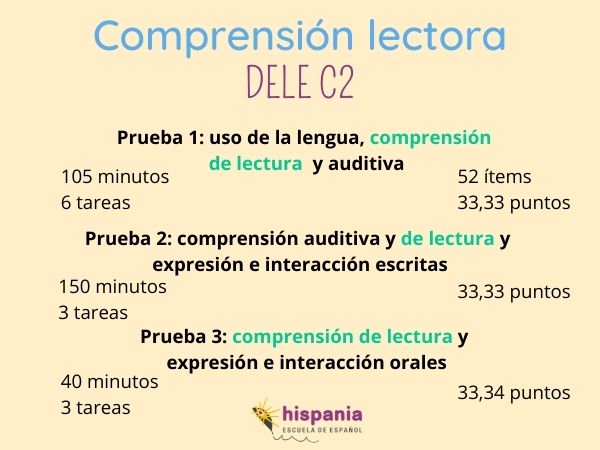
Reading comprehension Level C2
And finally we reach the last level. In the DELE C2 there are three great tests in which all skills are mixed.
Let's talk about the first test: Use of language, reading and listening comprehension.
This test has 6 tasks of 52 itemsand lasts 105 minutes and score up to 33.33 points.
Homework 1
- What is evaluated?
Identify the appropriate vocabulary, style and meanings of a very complex text.
- How is the homework?
Read an incomplete text with twelve spaces and choose one of the three options available for each.
- How are the texts?
Complex, specialized or literary text. Length: 300-400 words.
- Tips to do it right
Have command of the Spanish language at level C2. Know many verbs and synonyms.
Homework 2
- What is evaluated?
Reconstruct the structure and identify relationships between ideas in texts extensive writings.
- How is the homework?
Read an incomplete text and identify, among the seven available fragments, those corresponding to its six spaces.
- How are the texts?
Travel notebooks, blogs, stories, etc. Length: 550-650 words.
- Tips to do it right
The difficulty of the text and the fragments will be high. Please read them carefully and start doing the exercise when you have a clear idea of the idea important of each fragment.
Homework 3
- What is evaluated?
Locate important information in short academic texts.
- How is the homework?
Read six texts and relate them to eight sentences.
- How are the texts?
Reviews, theses, research articles, etc. Length: 100-150 words each text.
- Tips to do it right
Start by reading the sentences and relate them to the texts one by one.
Homework 4
- What is evaluated?
Understand the main points and extract data from an oral text.
- How is the homework?
Listen to a monologue and identify, among twelve available options, five ideas expressed in the text.
- How are the texts?
Lectures, speeches, long presentations… Length: 700 -750 words.
- Tips to do it right
From this task, listening is mixed with reading. Did you read our article on listening comprehension in the DELE? It's a good time 😉.
Homework 5
- What is evaluated?
Recognize intentions and implications in listening texts.
- How is the homework?
Listen to a conversation and relate fifteen ideas with the person who express.
- How are the texts?
Two or three oral texts from radio or television, from people who speak in interviews, programs or debates. Length: 800-850 words
- Tips to do it right
On the first listen, take as many notes as you can, without responding to the exercise. In the second listen, you should already relate the ideas with the corresponding person.
Homework 6
- What is evaluated?
Understand and identify specific data in debates or interviews.
- How is the homework?
Listen to a conversation and answer six questions with three choices of answer each.
- How are the texts?
Long radio or television text on complex topics. Length: 800-900 words.
- Tips to do it right
The same as before. It is a very long audio that is heard twice.
Use the first listening to identify the most important thing, to know what each person, take notes... and in the second answer the questions.
We have already finished this super guide on reading comprehension of the DELE exam.
It has been long, but it has been worth it.
Do you want to take the DELE exam and get an excellent grade?
Then sign up for our DELE courses at Hispania, escuela de español. Here you can prepare for the exam in person.
If you prefer, you can also access our courses of online DELE exam preparation to study quietly from home.
¡Un fuerte abrazo!
Article written by Carlos Martínez for Hispania, escuela de español
More articles

